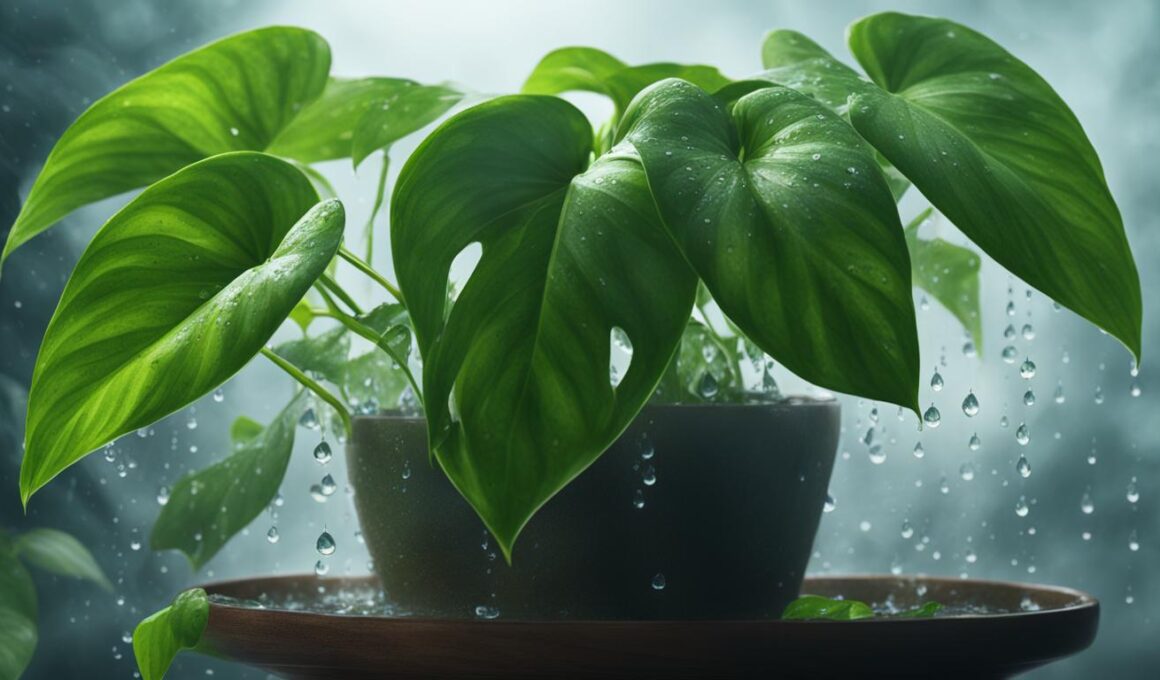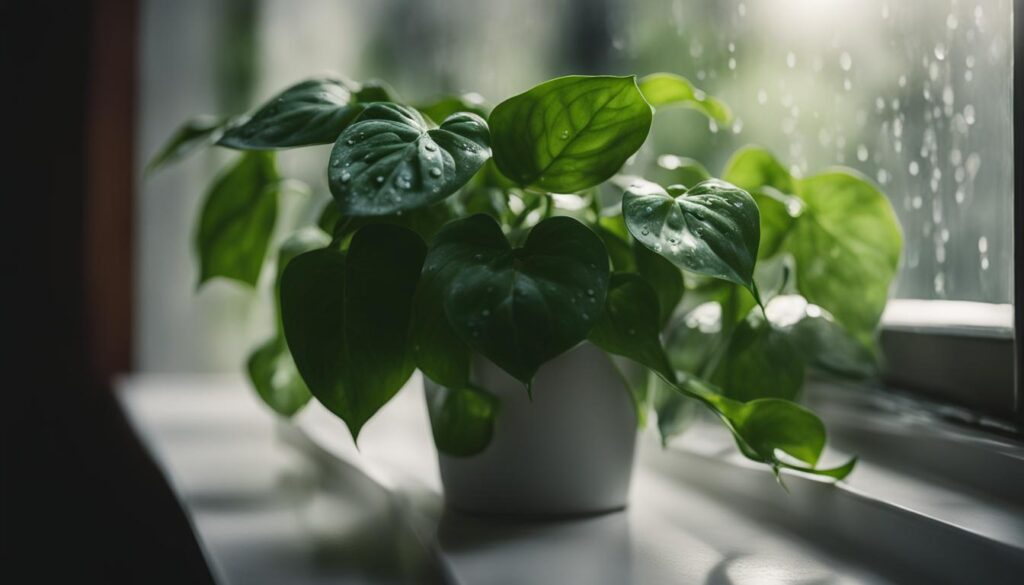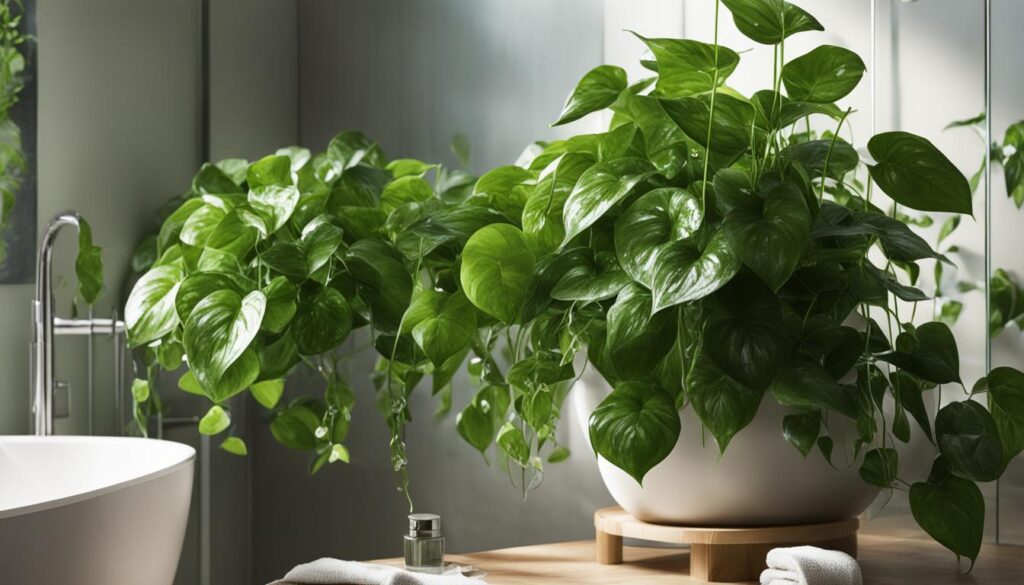Are you wondering if misting is beneficial for your Pothos plant? In this article, we’ll explore the relationship between Pothos and misting, and whether it’s necessary for the plant’s well-being. Understanding the proper care for your indoor plants, such as Pothos, is crucial for their growth and health.
Key Takeaways
- Misting your Pothos plant is not necessary and can harm it.
- Misting does not significantly increase humidity levels around the plant.
- Watering is more important for the plant’s growth and development.
- Pothos plants thrive in warm and humid environments.
- Monitoring humidity levels and providing proper care is essential for the health of your Pothos plant.
Why Misting Is Not Necessary for Pothos
Misting your pothos plant is often believed to increase humidity levels and promote its overall health. However, contrary to popular belief, misting is not necessary for pothos and can even have adverse effects on the plant’s well-being. Let’s explore why misting is not recommended for pothos care.
One of the main reasons misting is ineffective is that the water droplets from misting evaporate quickly, resulting in minimal moisture being added to the air. These tiny droplets do not significantly increase humidity levels around the plant, which is essential for its optimal growth. Instead, misting can create a damp environment on the plant’s leaves, attracting pests and promoting the development of fungal diseases.
To ensure the health of your pothos plant, it is crucial to focus on proper watering practices rather than misting. Watering the plant adequately and allowing the top 1-2 inches of soil to dry out between waterings is key. This allows the roots to receive sufficient moisture without risking overwatering or creating waterlogged conditions. By prioritizing watering over misting, you can provide your pothos with the hydration it needs to thrive.
“Misting does not significantly increase humidity levels around pothos plants and can create a suitable environment for pests and fungal diseases to thrive.”
Why Misting Is Not Necessary for Pothos
While misting may seem like a convenient way to provide moisture to your pothos, it is not an effective method for increasing humidity levels around the plant. Instead, focus on proper watering techniques and consider alternative methods for maintaining humidity, such as grouping plants together or using a humidifier. By giving your pothos the care it truly needs, you can ensure its health and longevity.
Table: Comparison of Misting and Watering for Pothos Care
| Aspect | Misting | Watering |
|---|---|---|
| Effect on Humidity | Minimal increase in humidity levels | Provides adequate hydration to the plant |
| Risk of Pest Infestations | Creates a favorable environment for pests | Less likely to attract pests |
| Risk of Fungal Diseases | Promotes fungal growth on leaves | Reduces the risk of fungal diseases |
| Moisture Delivery | Quick evaporation of water droplets | Allows roots to absorb water properly |
As the table illustrates, misting falls short in providing consistent humidity levels and poses risks to the plant’s health. Watering, on the other hand, ensures the plant receives adequate hydration and minimizes the likelihood of pest infestations and fungal diseases.
In conclusion, misting is not necessary for pothos care. Instead, focus on proper watering practices and consider alternative methods for maintaining humidity levels around the plant. By providing the necessary care and attention, you can maintain a healthy and thriving pothos plant in your home.
Watering Guidelines for Pothos
To ensure the proper growth and development of your pothos plant, it is crucial to follow the correct watering guidelines. Overwatering can lead to root rot, while underwatering can cause the plant to suffer from dehydration. By understanding the needs of your pothos and providing the right amount of water, you can help it thrive.
Pothos plants prefer slightly moist soil but do not tolerate waterlogged conditions. To determine when to water your plant, check the top 1-2 inches of soil. If it feels dry, it’s time to water. However, if the soil is still damp, wait a few more days before watering again. This will prevent overwatering and promote healthy root development.
When watering your pothos, ensure that water flows freely through the drainage holes of the pot. This will prevent water from pooling at the bottom, which can lead to root rot. It’s also beneficial to water the plant thoroughly, allowing the water to penetrate deep into the soil. This encourages the roots to grow downward in search of moisture, promoting a strong and healthy root system.
| Signs of Overwatering | Signs of Underwatering |
|---|---|
| – Yellowing leaves – Wilting – Foul odor – Root rot |
– Drooping leaves – Dry and crispy leaf edges – Stunted growth |
By following these watering guidelines, you can ensure that your pothos receives the right amount of hydration for optimal growth. Remember to be consistent with your watering routine and listen to your plant’s needs. With proper care, your pothos will thrive and bring beauty to your indoor space.
The Role of Humidity in Pothos Care
Pothos plants, also known as devil’s ivy, are tropical plants that thrive in warm and humid environments. Understanding the importance of humidity in pothos care is crucial for maintaining the health and well-being of these popular houseplants. Low humidity levels can have adverse effects on pothos plants, leading to symptoms such as brown and crispy leaf edges, wilting, and yellowing leaves.
Proper humidity levels are essential for pothos plants to thrive. Monitoring humidity levels in your home using a hygrometer can help you determine if the environment is suitable for your pothos. Ideally, the humidity should be maintained at a minimum of 50% or higher for optimal growth and health. If the humidity levels are consistently low, implementing methods to increase humidity becomes necessary.
Low Humidity Symptoms
When pothos plants are exposed to low humidity, they may exhibit several symptoms that indicate their discomfort. Some common signs of low humidity include:
- Brown and crispy leaf edges
- Wilting foliage
- Yellowing leaves
These symptoms occur because low humidity causes the plant to lose moisture more rapidly than it can absorb it from the surrounding environment. As a result, the leaves may become dehydrated and show signs of distress.
Increasing the humidity levels around your pothos plants is essential to alleviate these symptoms and ensure their well-being.
Measuring Humidity Levels
To measure the humidity levels in your home, you can use a hygrometer. This device provides an accurate reading of the humidity percentage in the air. By monitoring the humidity levels, you can make adjustments to create a more favorable environment for your pothos plants.
Methods to Increase Humidity
There are several effective ways to increase the humidity around your pothos plants:
- Grouping plants together: Placing multiple plants in close proximity can create a microclimate that retains moisture and increases humidity.
- Using a humidifier: A humidifier can add moisture to the air, increasing humidity levels in the room.
- Placing water bowls: Strategically placing bowls of water near the plants can help increase humidity through evaporation.
Implementing these methods will help provide the necessary humidity for your pothos plants and promote their overall health and growth.
| Humidity Levels | Recommended Action |
|---|---|
| Below 40% | Increase humidity using methods mentioned above |
| 40% – 50% | Consider increasing humidity for optimal growth |
| Above 50% | Humidity levels are sufficient for pothos plants |
Increasing Humidity for Pothos
If you want to increase humidity for your pothos plants, there are several effective methods you can try. These options provide a more consistent and substantial increase in humidity compared to misting. Let’s explore some of these techniques:
1. Mini Greenhouse
A mini greenhouse is a great way to create a humid microclimate for your pothos. It traps moisture and maintains higher humidity levels around the plant. You can purchase a small greenhouse or even create one using clear plastic containers or bags. Place the plant inside the mini greenhouse and ensure it receives adequate light and ventilation to prevent condensation and mold formation.
2. Aquarium
Using an aquarium is another creative way to increase humidity for your pothos. Fill the aquarium with water, but make sure the water level is below the soil line of the plant pot. As the water evaporates, it creates a humid environment around the plant. The glass walls of the aquarium also allow light to reach the plant while retaining moisture. Just remember to monitor the water level to avoid overfilling or drying out.
3. Grouping Plants Together
Grouping your pothos plants with other houseplants can also help increase humidity. As plants transpire, they release moisture into the air, creating a naturally humid environment. By placing your pothos alongside other plants, you can create a mini-ecosystem that benefits all the plants involved. Just make sure to group plants with similar care requirements to ensure they thrive together.
4. Using a Humidifier
If you’re looking for a convenient and adjustable solution, a humidifier can effectively increase humidity levels for your pothos. Humidifiers release controlled amounts of moisture into the air, creating a consistent humid environment. Place the humidifier near your pothos or in the same room to provide the necessary humidity. Remember to monitor and adjust the humidity levels based on the plant’s needs and the overall comfort of the space.
By implementing these methods, you can provide your pothos plants with the ideal humidity they need to thrive. Remember to maintain a balance and avoid excessive humidity, as it can lead to other issues like mold growth or root rot. Creating a suitable environment will contribute to the overall health and beauty of your pothos plants.
Summary:
- Mini greenhouses and aquariums are effective ways to create a humid environment for pothos plants.
- Grouping pothos with other plants can increase humidity through transpiration.
- Using a humidifier offers convenience and adjustable humidity control.
Placing Pothos in the Bathroom
If you’re looking to provide your pothos plant with higher humidity levels, especially during dry winter months, the bathroom can be an ideal location. Bathrooms tend to have increased moisture due to showers and baths, creating a more suitable environment for pothos plants. However, it’s important to note that while increased humidity is beneficial, the plant still requires indirect light and should not be exposed to direct sunlight.
“Placing your pothos plant in the bathroom can help create the perfect environment for its growth. The increased humidity mimics the plant’s natural habitat in tropical regions, providing it with the ideal conditions to thrive.”
When placing your pothos in the bathroom, ensure that it is positioned in an area where it can receive adequate indirect light. Place it near a window or in a well-lit corner to ensure it can photosynthesize effectively. Additionally, be mindful of ventilation in the bathroom to prevent excessive moisture buildup, which can lead to fungal issues.
| H3: Benefits of Placing Pothos in the Bathroom | |
|---|---|
| Higher Humidity: | Creates a more humid environment for the pothos plant, providing it with the moisture it craves. |
| Indirect Light: | Allows the plant to receive the necessary light for photosynthesis without direct exposure to harsh sunlight. |
| Bathroom Moisture: | The natural moisture in the bathroom helps mimic the tropical conditions that pothos plants prefer. |
Remember to consider the specific needs of your pothos plant, such as its watering requirements and the humidity levels in your bathroom. Regularly monitor the plant’s health and make adjustments as needed to ensure it continues to thrive in its new bathroom environment.
The Importance of Proper Pothos Care
Proper care is crucial for ensuring the health and growth of your pothos plants. By following a few key guidelines, you can create an ideal environment for these beautiful indoor plants to thrive.
First and foremost, it’s essential to establish a watering regime that is based on the moisture level of the soil rather than a rigid schedule. Pothos plants prefer slightly drying out between waterings, so check the top 1-2 inches of soil and water only when it feels dry. Overwatering can lead to root rot, which can be detrimental to the plant’s overall health.
Another important aspect of pothos care is maintaining the appropriate humidity levels. These tropical plants thrive in environments with humidity levels of at least 50% or higher. To achieve this, you can use methods such as grouping your plants together, using a humidifier, or placing the plant in a humid space like the bathroom. These techniques provide a more consistent and effective increase in humidity compared to misting.
In addition to watering and humidity, it’s crucial to use well-draining soil for your pothos plants. This helps prevent waterlogged conditions and ensures that the roots have access to the oxygen they need. You can either purchase a pre-made well-draining potting mix or create your own by combining regular potting soil with ingredients like perlite or vermiculite.
Lastly, it’s important to consider the temperature range for your pothos plants. These tropical plants prefer temperatures between 60-85°F (15-29°C). Avoid exposing them to drafts or extreme temperature fluctuations, as this can have a negative impact on their overall health and growth.
By following these care guidelines, you can provide your pothos plants with the best possible conditions for thriving. Remember to monitor the soil moisture, maintain adequate humidity, use well-draining soil, and keep the temperature within the ideal range. With proper care, your pothos plants will reward you with lush green foliage and a vibrant atmosphere in your home.
Pothos Care Guidelines
| Aspect of Care | Guidelines |
|---|---|
| Watering | Water when the top 1-2 inches of soil is dry, allowing slight drying between waterings. |
| Humidity | Maintain humidity levels of at least 50% or higher using methods like grouping plants, using a humidifier, or placing in a humid environment like the bathroom. |
| Soil | Use well-draining potting soil or create your own mix by combining regular potting soil with perlite or vermiculite. |
| Temperature | Keep temperatures between 60-85°F (15-29°C) and avoid exposing plants to drafts or extreme temperature fluctuations. |
Conclusion
In conclusion, misting your pothos plant is not necessary and can actually harm it. While misting may seem like a way to increase humidity levels, it does not significantly impact the moisture in the air around the plant. Instead, it can create a favorable environment for pests and diseases to thrive on the leaves.
Proper watering is key to the health and growth of your pothos plant. Water the plant when the top 1-2 inches of soil is dry, ensuring proper drainage to prevent waterlogged conditions. This will provide the plant with the hydration it needs to develop healthy roots and thrive, without the risk of root rot.
To maintain a suitable humidity level, there are more effective methods than misting. Grouping plants together, using a humidifier, or placing the plant in a humid environment like a bathroom can provide the additional moisture your pothos needs. These methods, combined with proper care and attention to the plant’s needs, will ensure its health and growth.
Remember, the well-being of your pothos plant depends on proper care and maintenance. By following the guidelines for watering, humidity, and overall plant health, you can enjoy a thriving and beautiful pothos in your home.
FAQ
Does Pothos Like To Be Misted?
Mist the plant regularly may harm it. Misting does not significantly increase humidity levels and can create a favorable environment for pests and diseases.
Why is misting not necessary for Pothos?
Misting does not effectively increase humidity levels around pothos plants. It can create a suitable environment for pests and fungal diseases to thrive. Watering the plant adequately is more crucial for its growth and health.
What are the watering guidelines for Pothos?
Adequate watering ensures healthy root development. Water the plant when the top 1-2 inches of soil is dry and ensure proper drainage to prevent overwatering and root rot.
What is the role of humidity in Pothos care?
Pothos are tropical plants that thrive in warm and humid environments. Low humidity can cause symptoms like brown and crispy leaf edges, wilting, and yellowing leaves.
How can I increase humidity for Pothos?
Increase humidity by using a mini greenhouse or aquarium, grouping plants together, using a humidifier, or adding bowls of water in the room. These methods provide a more effective and consistent increase in humidity compared to misting.
Can I place Pothos in the bathroom?
Placing Pothos in the bathroom can provide higher humidity levels, especially during dry winter months. Ensure the plant still receives indirect light and is not exposed to direct sunlight.
Why is proper Pothos care important?
Proper care, including watering regime, humidity maintenance, well-draining soil, and appropriate temperature, is essential for the health and growth of Pothos plants.
What should I consider for Pothos care?
Consider providing adequate humidity, following a watering regime based on soil moisture, using well-draining soil, maintaining the appropriate temperature range, and considering the use of a moss totem pole for vertical growth.











